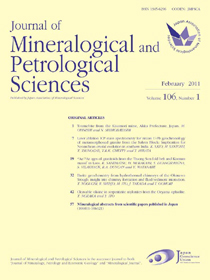Volume 119, Issue 1
Displaying 1-29 of 29 articles from this issue
- |<
- <
- 1
- >
- >|
ORIGINAL ARTICLE
-
2024Volume 119Issue 1 Article ID: 231222
Published: 2024
Released on J-STAGE: December 26, 2024
Advance online publication: December 03, 2024Download PDF (8918K) Full view HTML
ORIGINAL ARTICLE
-
2024Volume 119Issue 1 Article ID: 231013
Published: 2024
Released on J-STAGE: November 28, 2024
Advance online publication: November 05, 2024Download PDF (2587K) Full view HTML
ORIGINAL ARTICLE
-
2024Volume 119Issue 1 Article ID: 231002
Published: 2024
Released on J-STAGE: November 19, 2024
Advance online publication: October 25, 2024Download PDF (4872K) Full view HTML
ORIGINAL ARTICLE
-
2024Volume 119Issue 1 Article ID: 240729
Published: 2024
Released on J-STAGE: November 08, 2024
Advance online publication: October 11, 2024Download PDF (3045K) Full view HTML
ORIGINAL ARTICLE
-
2024Volume 119Issue 1 Article ID: 240616
Published: 2024
Released on J-STAGE: November 06, 2024
Advance online publication: October 11, 2024Download PDF (5987K) Full view HTML
ORIGINAL ARTICLE
-
2024Volume 119Issue 1 Article ID: 240722
Published: 2024
Released on J-STAGE: October 25, 2024
Advance online publication: October 07, 2024Download PDF (2688K) Full view HTML
ORIGINAL ARTICLE
-
2024Volume 119Issue 1 Article ID: 240404
Published: 2024
Released on J-STAGE: October 03, 2024
Advance online publication: September 10, 2024Download PDF (3399K) Full view HTML
ORIGINAL ARTICLE
-
2024Volume 119Issue 1 Article ID: 240509
Published: 2024
Released on J-STAGE: September 13, 2024
Advance online publication: August 20, 2024Download PDF (4064K) Full view HTML
ORIGINAL ARTICLE
-
2024Volume 119Issue 1 Article ID: 231215
Published: 2024
Released on J-STAGE: September 09, 2024
Advance online publication: August 08, 2024Download PDF (974K) Full view HTML
ORIGINAL ARTICLE
-
2024Volume 119Issue 1 Article ID: 240216
Published: 2024
Released on J-STAGE: August 27, 2024
Advance online publication: July 29, 2024Download PDF (2494K) Full view HTML
ORIGINAL ARTICLE
-
2024Volume 119Issue 1 Article ID: 230904
Published: 2024
Released on J-STAGE: August 26, 2024
Advance online publication: July 16, 2024Download PDF (4629K) Full view HTML
ORIGINAL ARTICLE
-
2024Volume 119Issue 1 Article ID: 240209
Published: 2024
Released on J-STAGE: August 21, 2024
Advance online publication: July 29, 2024Download PDF (2229K) Full view HTML
ORIGINAL ARTICLE
-
2024Volume 119Issue 1 Article ID: 240529
Published: 2024
Released on J-STAGE: July 30, 2024
Advance online publication: July 01, 2024Download PDF (2988K) Full view HTML
LETTER
-
2024Volume 119Issue 1 Article ID: 240220
Published: 2024
Released on J-STAGE: June 28, 2024
Advance online publication: May 22, 2024Download PDF (1430K) Full view HTML
ORIGINAL ARTICLE
-
2024Volume 119Issue 1 Article ID: 231025
Published: 2024
Released on J-STAGE: June 24, 2024
Advance online publication: May 27, 2024Download PDF (2331K) Full view HTML
ORIGINAL ARTICLE
-
2024Volume 119Issue 1 Article ID: 240122
Published: 2024
Released on J-STAGE: June 17, 2024
Advance online publication: May 10, 2024Download PDF (1718K) Full view HTML
ORIGINAL ARTICLE
-
2024Volume 119Issue 1 Article ID: 231223
Published: 2024
Released on J-STAGE: June 13, 2024
Advance online publication: May 23, 2024Download PDF (6328K) Full view HTML
ORIGINAL ARTICLE
-
2024Volume 119Issue 1 Article ID: 221212
Published: 2024
Released on J-STAGE: June 12, 2024
Advance online publication: March 26, 2024Download PDF (7594K) Full view HTML
ORIGINAL ARTICLE
-
2024Volume 119Issue 1 Article ID: 240229
Published: 2024
Released on J-STAGE: May 30, 2024
Advance online publication: May 09, 2024Download PDF (2759K) Full view HTML
ORIGINAL ARTICLE
-
2024Volume 119Issue 1 Article ID: 231207
Published: 2024
Released on J-STAGE: May 24, 2024
Advance online publication: April 22, 2024Download PDF (6211K) Full view HTML
ORIGINAL ARTICLE
-
2024Volume 119Issue 1 Article ID: 240304
Published: 2024
Released on J-STAGE: May 16, 2024
Advance online publication: April 23, 2024Download PDF (2843K) Full view HTML
LETTER
-
2024Volume 119Issue 1 Article ID: 231218
Published: 2024
Released on J-STAGE: May 16, 2024
Advance online publication: April 19, 2024Download PDF (1479K) Full view HTML
LETTER
-
2024Volume 119Issue 1 Article ID: 231218b
Published: 2024
Released on J-STAGE: March 29, 2024
Advance online publication: March 07, 2024Download PDF (1334K) Full view HTML
ORIGINAL ARTICLE
-
2024Volume 119Issue 1 Article ID: 230908
Published: 2024
Released on J-STAGE: March 27, 2024
Advance online publication: February 20, 2024Download PDF (1494K) Full view HTML
ORIGINAL ARTICLE
-
2024Volume 119Issue 1 Article ID: 230630
Published: 2024
Released on J-STAGE: March 22, 2024
Advance online publication: January 30, 2024Download PDF (3250K) Full view HTML
ORIGINAL ARTICLE
-
2024Volume 119Issue 1 Article ID: 231206
Published: 2024
Released on J-STAGE: March 08, 2024
Advance online publication: February 09, 2024Download PDF (5653K) Full view HTML
ORIGINAL ARTICLE
-
2024Volume 119Issue 1 Article ID: 230807
Published: 2024
Released on J-STAGE: February 22, 2024
Advance online publication: January 19, 2024Download PDF (5490K) Full view HTML
ORIGINAL ARTICLE
-
2024Volume 119Issue 1 Article ID: 230706
Published: 2024
Released on J-STAGE: February 06, 2024
Advance online publication: January 10, 2024Download PDF (2817K) Full view HTML
Errata
-
2024Volume 119Issue 1 Article ID: 241007
Published: 2024
Released on J-STAGE: December 03, 2024
Download PDF (33K) Full view HTML
- |<
- <
- 1
- >
- >|
